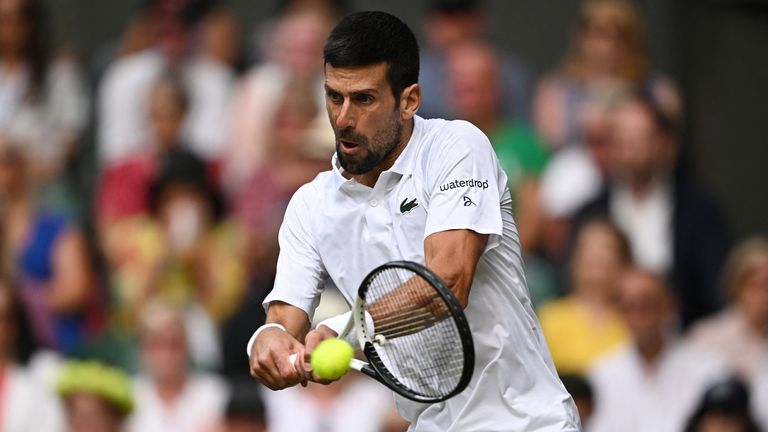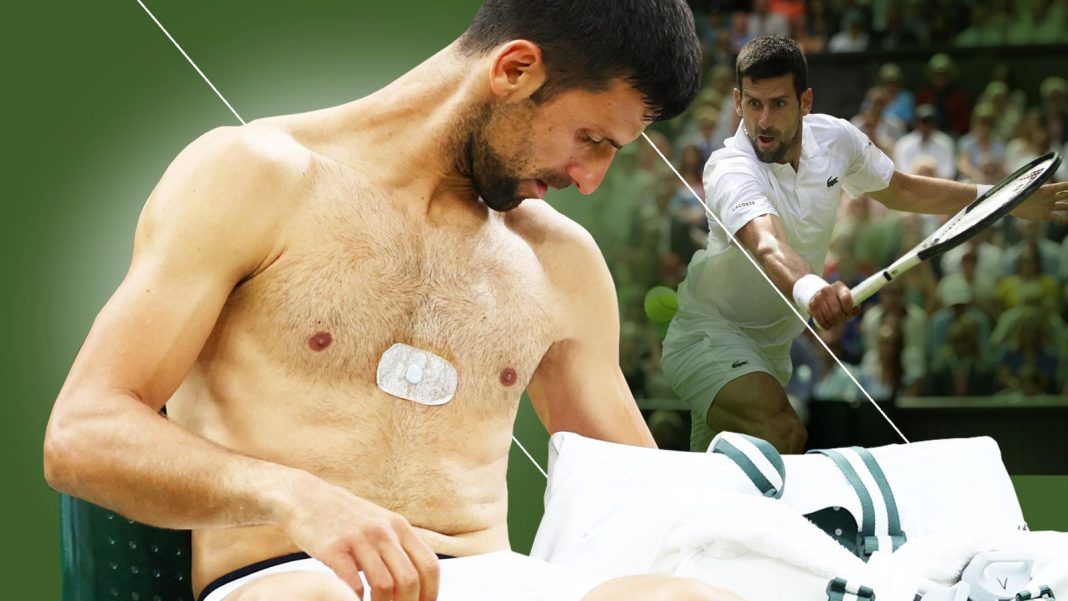Novak Djokovic has raised eyebrows at this year’s Grand Slams by revealing a mysterious metal disc strapped to his chest.
The tennis star had the coin-like device taped between his pectorals at the French Open and Wimbledon, and could wear it again when the US Open starts on Monday.
His first opponent is Alexandre Muller, as the Serb aims for a record-extending 24th Grand Slam men’s singles title.
The world number two sees the chest gadget as key to his success – so what is it?
‘Biggest secret of my career’
Djokovic was asked about the disc after his second round French Open win over Marton Fucsovics in May, after it caught the attention of bemused commentators and viewers.
“When I was a kid I liked Iron Man a lot,” he said, noting its resemblance to part of the Marvel superhero’s suit.
“So I try to impersonate Iron Man.”
Iron Man’s similarly-shaped chest device powers his robotic outfit, and is designed to prevent bullet shrapnel in his body from reaching his heart.
For Djokovic, no such problems. Instead, he said it’s all about enhancing his performance on the court.
“My team delivers incredibly efficient nanotechnology to help me deliver my best,” he said.
“That’s probably the biggest secret of my career. If it wasn’t for that, I probably wouldn’t be sitting here.”
Novak Djokovic wore the device at Wimbledon this year
What kind of ‘nanotechnology’ is this?
Following Djokovic’s comments, an Italian company called Tao Technologies said it was behind the device.
Described as a “human upgrade device”, the patented Taopatch is designed to improve health and wellbeing.
It claims the patch, which “uses two layers of nanocrystals that convert heart from your body into light”, sends therapeutic signals to the wearer’s nervous system to help their body achieve true balance.
Improved sleep, posture, balance, flexibility, recovery times, and focus, alongside reductions in stress, anxiety, and chronic pain, are among the benefits it purportedly provides.
The firm even claims the patch – which starts at £238 – has helped patients with multiple sclerosis.
Fabio Fontana, inventor of Taopatch and CEO of Tao Technologies, told Sky News he was inspired to invest in the product after becoming dependent on painkillers after a car accident.
“All the therapies I tried only provided temporary results,” he said.
“A doctor in Rome was the first to give me results with laser treatments. The benefits were significant in relieving the tension in the muscles of my neck and back, but its effectiveness lasted only a week.
“I wondered if it would be possible to create a kind of wearable laser to prolong the effect of the treatment.”
The nanocrystals, he said, simulate the effect of the laser treatments he received – and that the patch is simply “a different way of administering light therapy”.
More science and tech news:
The author using AI to help write novels
New list of risk factors for developing dementia
NASA explores potential supersonic passenger jet

The Serb says the patch helps him perform on the court
Are the claimed benefits legitimate?
Tao says its patch is an approved medical device, according to EU regulations, however is yet to be approved by America’s drugs regulator.
The firm cites studies into its effectiveness on its website. One Italian study in 2021 concluded it improved balance, movement, and affected limbs of multiple sclerosis patients, while another that looked into its impact on athletic performance said it had improved participants’ grip and squat strength.
Mr Fontana also pointed to studies into the benefits of light therapy, and said the patch was available to all research institutions that wanted to conduct clinical trials.
But Tao’s claims have failed to move some experts.
In an article for Science-Based Medicine, Dr Harriet Hall said the company’s explanation “is not credible”.
Dr Brandon Beaber, a neurologist, has suggested studies may suggest a “little bit of benefit” anecdotally, but they remained unproven so far as multiple sclerosis treatment.
And Professor Edzard Ernst, of the University of Exeter, told Sky News none of the company’s claims seemed “supported by sound evidence”.
“The notion that it generates any benefit is bogus,” he said.
“The principles put forward fly in the face of science.”
Prof Ernst said any benefit gained by Djokovic would “entirely depend on a placebo response”.

Djokovic during the Wimbledon men’s singles final
Given Djokovic has not been banned from using the patch, tennis authorities also appear unconvinced it provides tangible advantages.
The ATP Tour and International Tennis Federation have not commented on its use – and you could be forgiven for having doubts given Djokovic’s previous health positions.
The 36-year-old famously refused to take a COVID vaccine, and missed several tournaments as a result due to international travel restrictions.
He’s also previously suggested he believes some people have telepathic powers, gave up gluten after claiming proximity to a piece of white bread made his body feel weaker, and said having an operation on his elbow in 2018 caused him to feel “like I had failed myself”.
As for the “biggest secret” of his career, it’s now out in the open.
Whether it makes any difference or not, he’ll no doubt be among the main contenders at the US Open between now and the tournament’s end on 10 September.
The 2023 US Open starts on Monday 28 August, live on Sky Sports.







